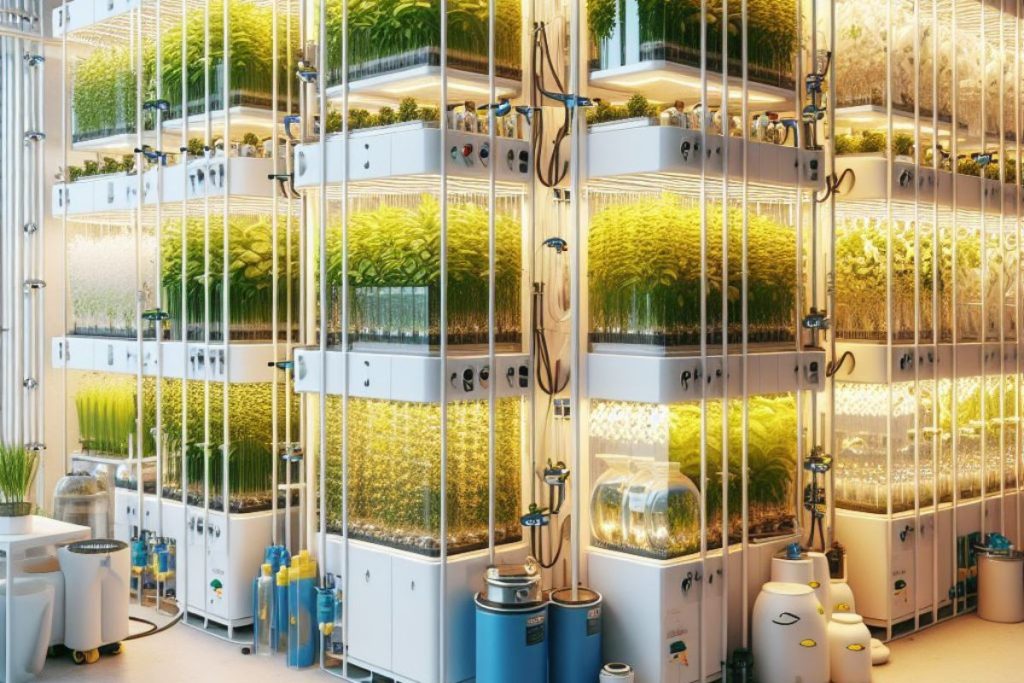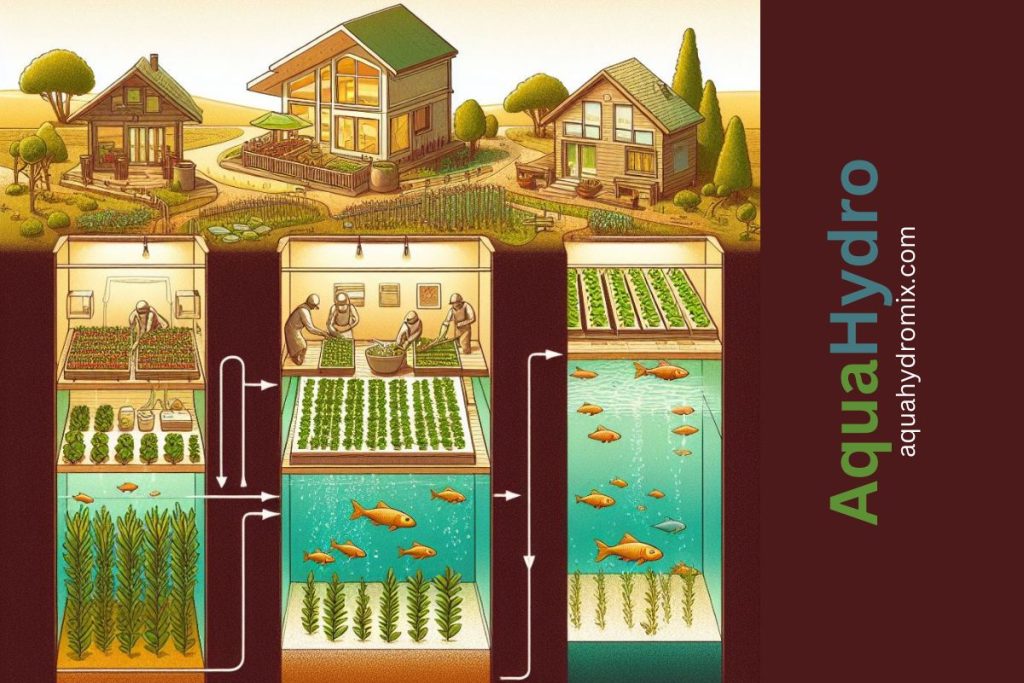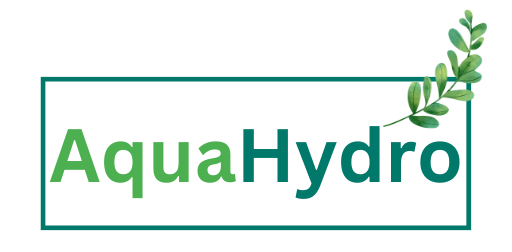Aquaponics vertical farming stands at the forefront of sustainable agriculture, heralding a revolutionary approach that seamlessly blends aquaculture and hydroponics. This innovative system creates a harmonious and symbiotic ecosystem, harnessing the power of synergy to optimize resource efficiency. In this comprehensive guide, we delve into the fundamentals of aquaponics, shedding light on its myriad advantages over conventional farming practices.
Understanding Aquaponics
What is Aquaponics?
Aquaponics is a sustainable farming method that integrates aquaculture (fish farming) and hydroponics (soilless plant cultivation). In this closed-loop system, fish waste provides nutrients for plants, and plants naturally filter and purify the water for the fish.

The Components of Aquaponics
Aquaponics systems consist of tanks for fish, grow beds for plants, and a recirculating water system. Beneficial bacteria play a crucial role in converting fish waste into plant-friendly nutrients.
Advantages of Vertical Farming in Aquaponics

Maximizing Space Utilization
Vertical farming allows for the efficient use of space, making it ideal for urban areas with limited land. By stacking layers of growing beds vertically, aquaponics systems can produce more food in a smaller footprint.
Water Conservation
Aquaponics employs a recirculating water system, minimizing water usage compared to traditional farming. The closed-loop design reduces the need for constant irrigation, making it an eco-friendly alternative.
Year-Round Crop Production
Vertical farming with aquaponics provides a controlled environment, enabling year-round crop production. This consistent output contributes to food security and stability in supply chains.
Setting Up Your Aquaponics Vertical Farm

Choosing the Right Location
Selecting an appropriate location is crucial for the success of your aquaponics farm. Factors such as sunlight exposure, accessibility, and climate play a significant role in determining the system’s effectiveness.
Essential Equipment
To set up an aquaponics vertical farm, essential equipment includes fish tanks, grow beds, pumps, and a reliable water filtration system. Choosing high-quality components ensures the longevity and efficiency of the system.
Fish and Plant Selection
Careful consideration of fish and plant species is essential for a balanced ecosystem. Compatibility in terms of nutrient requirements and environmental conditions is key for sustained growth.
Key Principles of Successful Aquaponics Farming
Maintaining Water Quality
Regular monitoring of water parameters, including pH, ammonia, and nitrate levels, is essential. Maintaining optimal water quality ensures the health of both fish and plants.
Achieving Proper Nutrient Balance
Balancing the nutrient input from fish waste with the needs of plants is critical. Adjusting fish feeding and monitoring plant growth helps maintain the equilibrium necessary for a thriving system.
Monitoring Environmental Factors
Environmental factors such as temperature and humidity impact the performance of an aquaponics system. Continuous monitoring and adjustments ensure a stable and productive environment.
Aquaponics vs. Traditional Farming

Resource Efficiency
Aquaponics excels in resource efficiency, utilizing water and nutrients more effectively than traditional farming methods. The closed-loop system minimizes waste and maximizes output.
Environmental Impact
Compared to conventional agriculture, aquaponics has a lower environmental impact, requiring fewer resources and producing less pollution. The absence of chemical fertilizers and pesticides contributes to healthier ecosystems.
Economic Viability
While initial setup costs may be higher, aquaponics systems can be economically viable in the long run. The potential for higher yields, reduced resource usage, and premium prices for organic produce contribute to economic sustainability.
Challenges and Solutions in Aquaponics Vertical Farming
Pest Management
Integrated pest management strategies, such as introducing beneficial insects, help control pests without the need for harmful chemicals.
Disease Control
Maintaining a clean and balanced system reduces the risk of diseases. Quarantine measures and proper fish health management contribute to disease prevention.
System Maintenance
Regular maintenance, including equipment checks and cleaning, is essential for the longevity of the system. Training in routine tasks ensures the smooth operation of the aquaponics farm.
Success Stories: Aquaponics Changing the Game
Urban Agriculture Transformation
Aquaponics has transformed urban spaces into productive agricultural hubs, providing fresh, locally grown produce in densely populated areas.
Community Engagement and Empowerment
Community-based aquaponics projects empower individuals and communities, fostering a sense of ownership and sustainability.
Educational Initiatives
Educational programs and initiatives centered around aquaponics contribute to increased awareness and adoption, shaping the future of sustainable farming.
The Future of Agriculture: Sustainable and Efficient
Scaling Up Aquaponics
The scalability of aquaponics holds great promise for addressing global food security challenges. Scaling up operations can lead to increased production and accessibility.
Innovations and Research
Ongoing research and innovations in aquaponics technology aim to enhance system efficiency, crop variety, and overall sustainability.
Global Adoption and Impact
As awareness grows, aquaponics is gaining traction globally, offering a sustainable solution for diverse agricultural landscapes.
Benefits Beyond Agriculture: Social and Environmental Impact
Employment Opportunities
The growth of aquaponics creates job opportunities in various fields, from system design and maintenance to marketing and education.
Reduced Carbon Footprint
By minimizing the need for long-distance transportation and chemical inputs, aquaponics contributes to a reduced carbon footprint in the food production chain.
Biodiversity Enhancement
Aquaponics systems can support biodiversity by creating habitats for beneficial organisms and promoting ecological balance.
Aquaponics Vertical Farming DIY: A Step-by-Step Guide
Building Your Vertical Farm Structure
Creating a solid foundation for your aquaponics venture begins with understanding the pivotal role of a well-designed vertical farm structure. This section introduces the significance of this initial phase, emphasizing how the physical setup forms the backbone of the entire aquaponics system. Readers gain insight into how a thoughtfully constructed structure sets the stage for the success and efficiency of their aquaponics journey.
Step-by-Step Instructions:
Navigating the construction process is made accessible to individuals of all experience levels through a systematic, step-by-step guide. This section breaks down the seemingly complex task into manageable and understandable steps. Whether you’re a seasoned enthusiast or a beginner, these instructions serve as a roadmap, ensuring that each phase of building the vertical farm structure is clear and achievable.
Essential Components:
Understanding the key components required for the vertical farm structure is crucial, and this section identifies and explains these fundamental elements. From grow beds and fish tanks to plumbing and support systems, readers gain a comprehensive understanding of the integral parts that make the aquaponics system thrive. Additionally, insights into material selection are provided, emphasizing the role of durability and efficiency in sustaining the structure.
Tips for Beginners:
Recognizing that some readers may be embarking on their first aquaponics project, this section offers tailored tips and advice. Beginners are guided through the construction process with insights into common challenges and practical solutions. The goal is to empower novices, ensuring that their introduction to aquaponics construction is not only educational but also successful.
Considerations for Optimal Environment:
Creating an environment conducive to both plant and fish health is a key focus in this section. Readers learn about essential considerations such as lighting, spacing, and ventilation. By understanding these factors, individuals can maximize the potential of their aquaponics system, fostering a thriving ecosystem within the constructed vertical farm.
Safety Measures:
The importance of safety during the construction process is underscored, emphasizing the well-being of the individuals involved and the long-term functionality of the vertical farm. Highlighted safety considerations and measures provide readers with the necessary precautions, ensuring that the construction is carried out securely. Adherence to safety guidelines is encouraged, promoting a secure and successful construction process.
Introducing Fish and Plants
Discover the key to a balanced and flourishing aquaponics system by selecting the right combination of fish and plants. Our guide offers expert guidance on species selection, introduction methods, and maintaining the delicate equilibrium between aquatic and plant life. Learn how to create a harmonious ecosystem that maximizes growth and yield, and gain insights into the specific needs of different fish and plant varieties.
Maintenance Tips for Success
Ensure the sustained success of your aquaponics vertical farm with our valuable maintenance tips and best practices. From water quality management to routine checks on system components, this section covers everything you need to know to keep your aquaponics system running smoothly. Learn how to troubleshoot common issues, prevent potential problems, and create a maintenance schedule that fits seamlessly into your routine, promoting the longevity and productivity of your vertical farm.
Educating the Masses: Spreading Awareness
Community Workshops
Organizing workshops to educate communities about the benefits and implementation of aquaponics.
Online Resources and Platforms
Utilizing online platforms to disseminate information, share success stories, and connect with a global audience.
Collaborative Initiatives
Fostering collaboration among individuals, organizations, and governments to promote widespread adoption and awareness.
The Green Revolution: Aquaponics in Urban Spaces
Rooftop Farms
Exploring the potential of utilizing rooftops for aquaponics, transforming urban landscapes into productive green spaces.
Repurposing Abandoned Structures
Revitalizing abandoned structures for aquaponics farming, contributing to urban renewal and sustainable land use.
Vertical Farming in Commercial Buildings
Adapting commercial buildings for vertical aquaponics farming, integrating agriculture into commercial spaces for a dual-purpose approach to sustainability.
The Economics of Aquaponics: Cost and Profitability
Initial Investment
While the initial investment for aquaponics systems may be higher compared to traditional farming, the long-term benefits and reduced operational costs contribute to a favorable return on investment.
Return on Investment
Aquaponics offers a potential return on investment through increased crop yields, reduced resource expenditures, and the ability to command premium prices for organically grown produce.
Government Support and Subsidies
Government support and subsidies for sustainable agriculture practices further enhance the economic viability of aquaponics. Incentives may include grants, tax breaks, and technical assistance programs.
In conclusion, aquaponics vertical farming stands at the forefront of sustainable agriculture, offering a transformative approach to food production. Its advantages in space utilization, water conservation, and year-round crop production make it a compelling solution for the challenges faced by traditional farming. While challenges exist, ongoing research, community engagement, and educational initiatives are driving the global adoption of aquaponics.
As we look to the future, the promise of scalability, innovations, and economic viability positions aquaponics as a key player in the pursuit of a more sustainable and efficient agricultural landscape. By embracing aquaponics, we contribute not only to the well-being of our planet but also to the social and economic development of communities worldwide. The journey towards a greener, healthier, and more resilient future begins with the revolutionary possibilities of aquaponics vertical farming.

